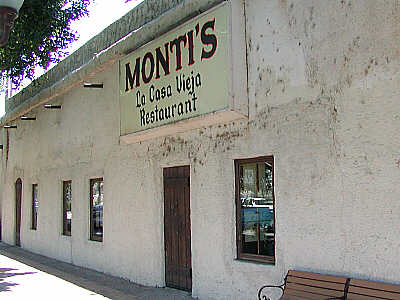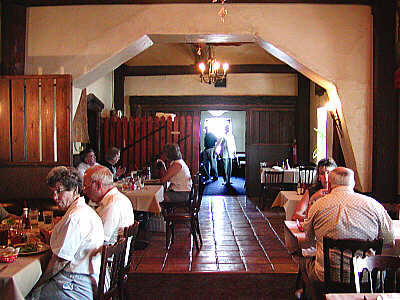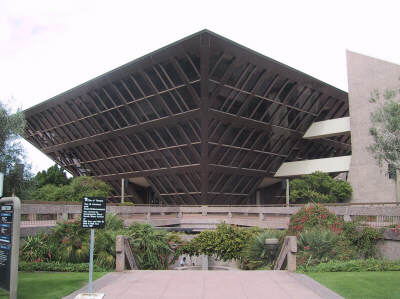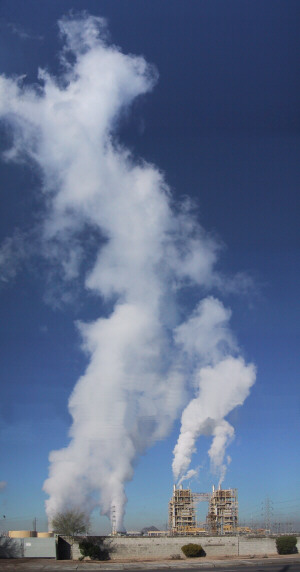| |
|
It's pronounced "tem-pee,"
accent on the "pee," much to the consternation of visitors
whose sensibilities are offended by a city with such a syllable in
its name. It's Greek, not Spanish, and has no logical
connection to the valley other than the location reminded Darrel
Duppa of "the lovely vale in Thessaly, celebrated by the
classical poets." Mr. Duppa had apparently exhausted his
creative energies in coming up with the more appropriate and
pleasant sounding "Phoenix."2
When a community which is not much more than possible site for a
ferry crossing of the raging Salt River is given a highfalutin Greek
name, one might expect the community to be a bit uppity. One
might be right.
|
 |
| Montis La Casa Vieja Restaurant is in
"the old house" where Hayden's Ferry crossed the
turbulent Salt River. 4-02. |
|
 |
| Meals are now served in the old adobe house
where Senator Carl Hayden was born in 1877. Behind the
camera, a portion of the wallboard has been removed so guests
can see the adobe wall. 4-02. |
|
 |
| Tempe City Hall.
11-00 |
|
|
Tempe's Upside-Down City Hall at 31 East 5th Street
has to be the most distinctive municipal building in the
state, if not the nation. The pyramid is 3 stories tall
containing 17,650 square feet of municipal offices, including
offices for the Mayor, City Council, and City Manager on the
third floor. The 45� slope of the walls results in the floors
on that level to measure 100 feet on each side, but the
ceiling to measure 126 feet on each side.
The majority of the office space in this 50,000 square foot
complex is in perimeter offices around the sunken 2.5 acre
plaza and below the plaza itself. Access to the pyramid
is through bridges over the plaza area to the entrance at the
ground floor of the pyramid, while the plaza offices can be
reached by adjacent exterior stairways to plaza. A 3
story concrete structure to the east of the pyramid provides
emergency fire exits.
Construction, started in 1969, was completed in 1971, at a
cost of $52,500,000.
While the Tempe City Hall is unique among city halls, the
inverted pyramid is not unique to architecture. Other
inverted pyramids are The
Pier, St. Petersburg, FL; the Canadian
Pavilion at the Expo 67, the 1967 World's Fair in Montreal
Canada
Sources:
William C. Weinaug, Building Description Report on the
Tempe Municipal Building, Pennsylvania State University,
October 13, 1980.
Victor A. Talther, Jr., "Steel, Glass Building erected
in Southwest," American Institute of Steel Construction,
Los Angeles, California
|
|
 |
| The Ocotillo Power Plant of Arizona Public
Service Company, just east of the Arizona State University
campus was built in 1960. At that time it had twin 15
story towers for the two natural gas and oil boilers. In
the 1970's, two combustion turbines were added bringing its
capacity to 340 megawatts. This is about 9% of the
capacity of the Palo Verde nuclear facility. Pinnacle
West Energy. 2-01 |
Quoting the Will C. Barnes, Arizona Place Names entry for
Tempe:
On Salt River, 9 miles east of Phoenix. Hinton says:
"In 1870, Jack Swilling who a few years before had built
the first irrigating canal in the valley at the present Phoenix,
seeking new fields to conquer, went up the river and took out
another canal near the black butte on the south side of the river.
"Darrel Duppa, who suggested the name of Phoenix, again
came to the front with the name Tempe, because, as he explained
'its beautiful location reminded him of the lovely vale in
Thessaly, celebrated by the classical poets.' And so it was
christened by this somewhat exotic name.
"Just as the new name was finding its way into use,
Charles T. Hayden, father of Senator Carl Hayden, happened along
looking for a location.
"'Don Carlos,' as he was called by old timers, was a
trader and promoter, not a farmer. It looked like a good
point for a store, so he opened one. Likewise he started a
blacksmith and wagon shop; also a grist mill with water power from
the canal. The river was often unfordable, and so Hayden
operated a ferry with a long rope. Soon the place was known
as 'Hayden's Ferry,' and so showed on many early maps. But
the name 'Tempe' prevailed and the theme of a Greek poet found a
place in the Arizona desert." Hinton.
Hinton always wrote this name "La Tempe," but as
McClintock remarks, "the word is not Spanish and should be
pronounced as spelled: Tempee."
McClintock and Farish both discuss at length these names and
their interesting sponsors. P. O. established May 5, 1879.
Barnes, Arizona Place Names, p. 439.
Sources cited by Barnes:
Farish, Thomas E., History of Arizona, 1916.
Hinton, R. J., Handbook of Arizona, 1878.
McClintock, James H., History of Arizona, 1916. Mormon
Settlement, 1921.
City of Tempe web site.
|
| |
|
1. "Table DP-1. Profile of General Demographic
Characteristics: 2000--Arizona," American
FactFinder, U.S. Census Bureau. 
2. Will C. Barnes, Arizona Place Names, The
University of Arizona Press, Tucson, 1988, p. 439. 
|
|


